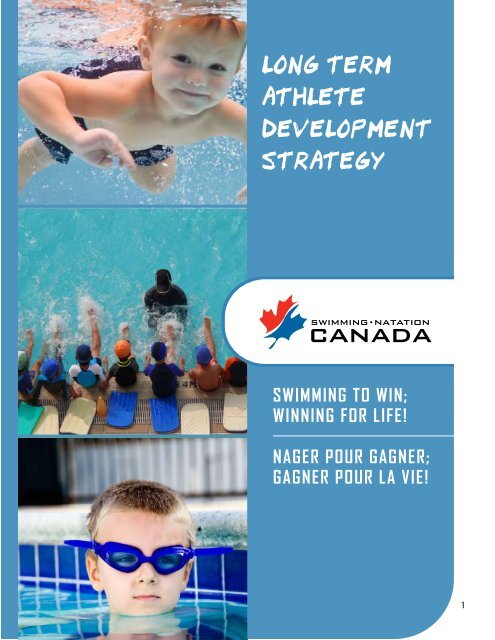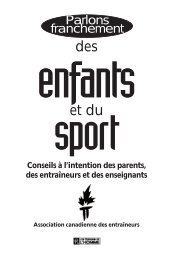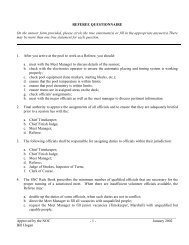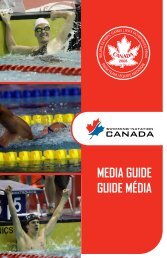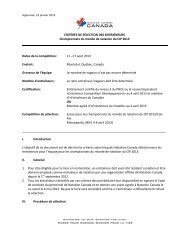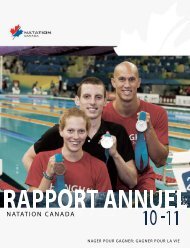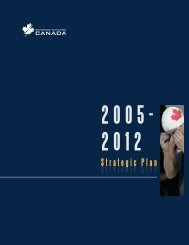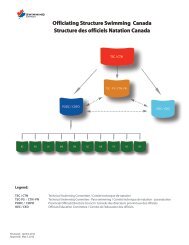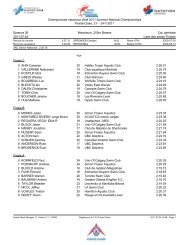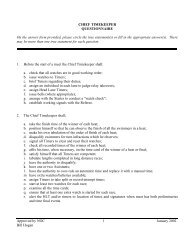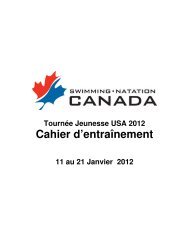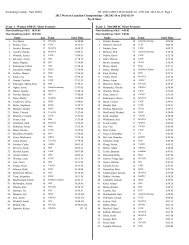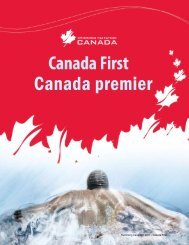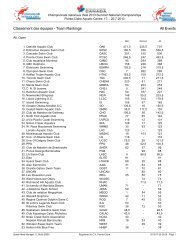Long Term Athlete Development Strategy (LTAD) - Swimming Canada
Long Term Athlete Development Strategy (LTAD) - Swimming Canada
Long Term Athlete Development Strategy (LTAD) - Swimming Canada
You also want an ePaper? Increase the reach of your titles
YUMPU automatically turns print PDFs into web optimized ePapers that Google loves.
LONG TERM<br />
ATHLETE<br />
DEVELOPMENT<br />
STRATEGY<br />
1
We acknowledge the financial support<br />
of the Government of <strong>Canada</strong> through<br />
Sport <strong>Canada</strong>, a branch of the Department<br />
of Canadian Heritage.<br />
Published by: <strong>Swimming</strong> <strong>Canada</strong>, Ottawa, <strong>Canada</strong>, 2008<br />
All rights reserved. No part of this work may be reproduced or transmitted in any form for<br />
commercial purposes, or by any means, electronic or mechanical, including photocopying<br />
and recording or from any information stored in a retrieval system, without permission from<br />
the authors or <strong>Swimming</strong>/Natation <strong>Canada</strong>.<br />
ISBN 978-0-9809299-0-4
TABLE OF CONTENTS<br />
Dedication ............. 4<br />
Preface and Acknowlegdements ............. 5<br />
Strategic Plan Alignment ............. 6<br />
Key Objectives ............. 7<br />
<strong>LTAD</strong> - 11 Key Factors ............. 8<br />
Sport System Review ............ 12<br />
Understanding growth and development ............ 14<br />
Physiology of growth and development ............ 15<br />
<strong>LTAD</strong> Gender Considerations ............ 16<br />
Peak Height Velocity ............ 18<br />
Windows of Optimal Trainability ............ 19<br />
<strong>LTAD</strong> Stages Overview ............ 20<br />
Phase 1 - Active Start ............ 22<br />
Phase 2 - FUNdamentals ............ 24<br />
Phase 3 - Learn to Train ............ 26<br />
Phase 4 - Train to Train ............ 28<br />
Phase 5 - Train to Compete ............ 30<br />
Phase 6 - Compete to Win ............ 32<br />
Phase 7 - Second Career / Active for Life ............ 34<br />
Glossary of <strong>Term</strong>s ............ 36<br />
Selected Bibliography ............ 38
The Canadian swimming community was saddened to lose one of its<br />
top coaches and mentors, Dr. Jeno Tihanyi, on March 4, 2007.<br />
Dr. Tihanyi’s coaching achievements included 16 world records, being<br />
named Canadian swim coach of the year four times and induction to the<br />
Canadian Olympic Hall of Fame. A Professor at the School of Human<br />
Kinetics at Laurentian University, Dr. Tihanyi taught in the area of<br />
human growth and development and successfully applied his<br />
knowledge in this area to his coaching. Dr. Tihanyi’s published work in<br />
his specialty is recognized world wide.<br />
Dr. Tihanyi, known as “Doc” in the swimming community, was coach<br />
to many swimmers over a long coaching career, Alex Baumann being<br />
the most famous. Doc began to teach the future Olympic champion<br />
when Baumann was just 9 and nurtured him to two individual medley<br />
gold medals in world-record times at the 1984 Los Angeles Olympics.<br />
This document is dedicated to Dr. Jeno Tihanyi in recognition of a lifetime<br />
commitment to swimming and education.<br />
4<br />
“Doc was a meticulous planner who left nothing to chance when it<br />
came to achieving goals. He was one of the first to incorporate<br />
science with the ‘art of coaching’ and believed very strongly in a<br />
long term athlete development approach.”<br />
Alex Baumann
<strong>LTAD</strong> <strong>Strategy</strong>: Key Objectives<br />
The <strong>Long</strong> <strong>Term</strong> <strong>Athlete</strong> <strong>Development</strong> <strong>Swimming</strong> strategy (<strong>LTAD</strong>S) objectives include the following<br />
observable outcomes:<br />
1<br />
Clubs and coaches will be provided with a developmentally appropriate structure<br />
for the development of skills across physical, technical, tactical, mental and lifestyle<br />
categories.<br />
2<br />
A National competitive structure will be implemented that provides appropriately<br />
scheduled competition and progressive challenges through an athlete’s career.<br />
3<br />
The <strong>LTAD</strong>S will provide enhanced high performance success at the international and<br />
domestic level. Better skilled and more athletic athletes will be produced, and more athletes<br />
will continue in the sport to ages where they are able to reach maximum potential.<br />
4<br />
<strong>LTAD</strong>S reinforces the coach, parent and administrator’s primary role - to create a sport<br />
experience that provides each young participant with the opportunity to achieve success to<br />
their highest capabilities, and to continue a life of active living.<br />
5<br />
A national sport system for swimming will be created that truly supports the vision of<br />
<strong>Swimming</strong> <strong>Canada</strong>: <strong>Swimming</strong> to Win - Winning for Life.<br />
In support of these objectives, the following additional documents will be created<br />
<strong>LTAD</strong>S - Competition Review<br />
....a full review of the Canadian swimming competitive structure, with recommendations<br />
in support of the long term athlete development strategy<br />
<strong>LTAD</strong>S - Stage Skills Checklists<br />
....a stage by stage description of activities and skills that a child/athlete should be exposed<br />
to, and methods of benchmarking their achievement.<br />
<strong>LTAD</strong>S - Implications for Clubs and Parents<br />
....issues for Clubs and Parents to consider, based on the implementation of long term<br />
athlete development strategies at a Club level<br />
<strong>LTAD</strong>S - NCCP Integration<br />
....all NCCP coaching certification materials will be fully reviewed and aligned with long<br />
term athlete development terminology and messaging<br />
5<br />
7
PREFACE & ACKNOWLEDGEMENTS<br />
<strong>Swimming</strong> <strong>Canada</strong> is pleased to introduce the <strong>Long</strong> <strong>Term</strong> <strong>Athlete</strong> <strong>Development</strong> <strong>Strategy</strong> for<br />
<strong>Swimming</strong>. This document has been created as a guide for the coaches, administrators and<br />
parents of the swimming community across <strong>Canada</strong>.<br />
This document would not have been possible without the support of the <strong>Long</strong> <strong>Term</strong><br />
<strong>Athlete</strong> <strong>Development</strong> Expert Group and the support of <strong>Swimming</strong> <strong>Canada</strong> staff, especially<br />
Ken Radford, who first published his thoughts on these matters in 2000. As with many things<br />
in the sporting community, new concepts that involve change can be slow to be adopted, but<br />
are never possible without the leadership of those looking to lead the change.<br />
I would also like to thank Alain Lefebvre from Fédération de natation du Québec, who has<br />
taken the concepts presented within Ken Radford’s initial document and implemented them<br />
across Québec. We are seeing very strong results from Québec and Alain’s feedback on this<br />
document has been very helpful.<br />
Finally, we offer a great deal of gratitude to Dr. Jeno Tihanyi for the leadership and unwavering<br />
commitment he had to this topic, and indeed this project. Doc’s work with Swim Ontario<br />
and his expectation of quality in this project has challenged the editor at many stages, but<br />
I trust and hope the final product would have been given the ‘thumbs up’ from one of our<br />
countries very best.<br />
Andrew Moss<br />
<strong>LTAD</strong> Expert Committee and Working Group:<br />
Dr. Stephen Norris<br />
Dr. John Hogg<br />
Dr. Larry Holt<br />
Dr. Jeno Tihanyi<br />
Alain Lefebvre<br />
Nigel Kemp<br />
Istvan Balyi<br />
Richard Way<br />
<strong>Swimming</strong> <strong>Canada</strong> <strong>LTAD</strong> Working Group:<br />
Ken Radford<br />
Andrew Moss<br />
Martin Richard<br />
Graphic Design:<br />
6
Alignment to <strong>Swimming</strong> <strong>Canada</strong>’s Strategic Plan<br />
The Strategic Plan directs the activity of the swimming community towards the achievement of<br />
long and short term objectives through five Strategic Imperatives:<br />
ELITE To implement a sustainable reliable program focused on performance<br />
A successfully implemented long term athlete development strategy will deliver athletes to the<br />
National team with greater potential for improvement at an age where optimal performance is<br />
possible. An effective development strategy will also deliver athletes with advanced abilities across<br />
all physical, technical, tactical, psychological and lifestyle skill sets. These athletes will provide<br />
greater depth to the National Team across all disciplines, and will provide <strong>Canada</strong> with an improved<br />
opportunity for elite success against an ever improving competitive field.<br />
SPORT SYSTEM To implement a nationally aligned and integrated sport system that fully<br />
optimizes individual potential<br />
A long term athlete development strategy that is aligned at Club, Provincial/Territorial and National<br />
levels, delivers the “integrated sport system” directed by the strategic plan. While this document<br />
and the supplementary materials to follow are important, it will be the successful determination of<br />
roles, responsibilities and funding of the implementation of the athlete development strategy that<br />
will determine its success.<br />
PEOPLE DEVELOPMENT To implement a harmonized, accountable system that is committed<br />
to the development and recognition of individuals who support the development of our athletes<br />
(coaches, administrators at all levels, officials and parents)<br />
The long term athlete development strategy provides a framework that will direct the development<br />
of programs to support all participants involved in the athlete development process.<br />
PARTNERSHIPS To generate collaborations that maximize opportunities for Canadian swimming<br />
The successful implementation of a long term athlete development strategy will require partnerships<br />
and professional alliances with groups that in the past may have been considered as ‘‘competitors’’<br />
for our athletes. These groups will include learn to swim providers and associated swimming<br />
organizations such as summer, high school, synchro, waterpolo, diving, triathlon and masters.<br />
<strong>Swimming</strong> must also realize that the delivery of some vital motor skill requirements to young<br />
developing swimmers can be best accomplished through the expertise provided by programs<br />
delivered by sports such as gymnastics and athletics. Finally, as athletes fully realize the effects<br />
of maturation, our sport must look at complimentary sport experiences for athletes looking for<br />
alternate opportunities to pursue their sporting and social objectives.<br />
BUSINESS MANAGEMENT To implement an accountable and innovative approach to build a<br />
sustainable and nationally aligned business structure to ensure performance oriented swimming.<br />
A successfully implemented long term athlete development strategy provides greater member<br />
retention as well as powerful sponsor opportunities. The strategy also directs investment to<br />
appropriate programs delivered by the stakeholders identified as responsible for each stage of<br />
development.<br />
7
<strong>Long</strong> <strong>Term</strong> <strong>Athlete</strong> <strong>Development</strong><br />
11 Key Factors<br />
<strong>LTAD</strong> focuses on the general framework of athlete development with special reference<br />
to growth, maturation and development, trainability, and sport system alignment and<br />
integration. It incorporates information from a number of sources. It draws on the<br />
experiences of various athlete development projects that have been implemented by<br />
a variety of National Sport Organizations in <strong>Canada</strong> and around the world since the<br />
mid-1990s. The <strong>LTAD</strong> program also draws from the Report of the Minister of State’s (Sport) Work<br />
Group on Sport for Persons with a Disability (2004).<br />
The <strong>LTAD</strong> approach was also influenced by an analysis of the empirically tested athlete development<br />
models from the former East Bloc countries, with all the positive and negative aspects of those<br />
models. In addition, sport science has provided insight and information regarding the role of<br />
growth, development, and maturation in athletic development. These sciences include pediatric<br />
exercise science, exercise physiology, sport psychology, psychomotor learning, sport sociology,<br />
and nutrition. An analysis of the literature on organizational development has also contributed<br />
significantly.<br />
This document is supported by the coaching and exercise science literature. We have chosen<br />
to write this document in the language and context of coaches and sport leaders. Although<br />
some generalizations may seem to be too vague from a scientific point of view, the directions<br />
drawn from the literature have been made to support the notion that coaches operate in an ever<br />
changing environment, and their artfulness in implementing the <strong>LTAD</strong> <strong>Strategy</strong> is critical.<br />
We recognize that many of the subjects covered in this initial document for swimming are<br />
significant and complex subjects. We have made a decision to launch the <strong>Swimming</strong> <strong>Canada</strong><br />
<strong>Long</strong> <strong>Term</strong> <strong>Athlete</strong> <strong>Development</strong> <strong>Strategy</strong> in staged chapters, ensuring each topic can be fully<br />
developed, while maintaining a readable and easy to reference format.<br />
While much of the content is applicable, we have also drawn on the expertise of the Sport<br />
<strong>Canada</strong> <strong>LTAD</strong> expert group for <strong>LTAD</strong> implementation considerations for athletes with a disability<br />
by providing “No Accidental Champions”, the <strong>LTAD</strong> resource book for athletes with a disability.<br />
As well, a specific resource for coaches, “Coaching <strong>Athlete</strong>s with a Disability”, produced by the<br />
Coaches Association of Cananda, has been included.<br />
8
The 10 Year Rule<br />
Scientific research has concluded that it takes a minimum of 10 years and 10,000 hours of training for a<br />
talented athlete to reach elite levels. This factor is supported by The Path to Excellence, which provides<br />
a comprehensive view of the development of U.S. Olympians who competed between 1984 and 1998.<br />
The results reveal that U.S. Olympians begin their sport participation at the average age of 12.0 for<br />
males and 11.5 for females.<br />
The FUNdamentals<br />
The development of a comprehensive repertoire of movement and sport skills – otherwise<br />
known as physical literacy - should be considered a requirement for the early stages of sport<br />
involvement for a young child. The skills to be developed are the ABC’s (Agility, Balance,<br />
Coordination, Speed), RJT (running, jumping, throwing), KGB (kinesthetics, gliding, buoyancy,<br />
striking with a body part) and CKs (catching, kicking, striking with an implement). In order to<br />
develop basic movement literacy, participation in as many sports as possible is encouraged.<br />
Partnerships with other sport providers, or FUNdamentals based programming within a Swim<br />
Club, are encouraged to activate this group of entry level participants.<br />
<strong>Development</strong>al Age<br />
The terms growth and maturation are often used together and sometimes synonymously.<br />
However, each refers to specific biological activities. Growth refers to observable step-by<br />
step changes in quantity and measurable changes in body size such as height, weight, and fat<br />
percentage. Maturation refers to qualitative system changes, both structural and functional, in<br />
the body’s progress toward maturity such as the change of cartilage to bone in the skeleton.<br />
<strong>Development</strong> refers to “the interrelationship between growth and maturation in relation to the<br />
passage of time. The concept of development also includes the social, emotional, intellectual,<br />
and motor realms of the child.”<br />
Chronological age refers to the number of years and days elapsed since birth. Children of<br />
the same chronological age can differ by several years in their level of biological maturation.<br />
<strong>Development</strong>al age refers to the degree of physical, mental, cognitive, and emotional maturity. The<br />
relative developmental age can be determined by skeletal maturity or bone age after which mental,<br />
cognitive, and emotional maturity is incorporated.<br />
<strong>LTAD</strong> requires the identification of early, average, and late maturers in order to help to design<br />
appropriate training and competition programs in relation to optimal trainability and readiness.<br />
The beginning of the growth spurt and the peak of the growth spurt are very significant in <strong>LTAD</strong><br />
applications to training and competition design. Specific disabilities may dramatically change the<br />
timing and sequence of childhood and adolescent development.<br />
Currently, most swimming training and competition programs are based on chronological age.<br />
However, athletes of the same chronological age between 10 and 16 can be 4 to 5 years apart<br />
developmentally. Thus, chronological age is a poor guide to segregate adolescents for competition.<br />
Training Age refers to the age where athletes begin planned, regular involvement in training.<br />
The tempo of a child’s growth has significant implications for athletic training because children<br />
who mature at an early age have a major advantage during the Training to Train stage compared<br />
to average or late maturers. However, after all athletes have gone through their growth spurt,<br />
it is often later maturers who have greater potential, provided they experience the same<br />
quality coaching throughout the early phases. Coaches and parents must maintain a focus on<br />
process and mastery of skill for the late maturer, providing the background for success later in their<br />
career.<br />
9<br />
9
Specialization<br />
<strong>Swimming</strong> skills should be introduced at very early ages, and refined through the key motor learning<br />
Fundamentals stage. The important balance at these early stages in one of skill development versus<br />
performance development. Our sport has seen many examples of athletes undertaking adult oriented<br />
training programs at these early stages, being “age group” stars, but never heard from again later in their<br />
careers. In fact, likely the most determining factor to elite success is the extent to which the technical,<br />
physical and psychological attributes of a physically literate child are affected by adolescence.<br />
Except in rare cases where athletes reach elite performance prior to adolescence, most elite<br />
performers in swimming are into their 20’s before reaching their maximum performances.<br />
The impact of this? Talent and elite potential are extremely difficult to assess until children fully realize<br />
adolescence. Prior to this stage, the key focus should be on the development and mastery of skills,<br />
and the acquisition and expression of a love for the sport.<br />
Peak Height Velocity<br />
The long term athlete development strategies referenced in these and other documents refer to<br />
age at peak height velocity as a key reference point for readiness. Age at peak height velocity<br />
refers to the age when the rate of increase of height reaches it’s maximum. In order to use<br />
this measure effectively, regular anthropometric monitoring is required.<br />
Recommended frequency of measurement is every three months. In order to effectively monitor the<br />
rate of change, it is very important that the frequency of measurement is consistent, and started at an<br />
early enough age to identify important PHV changes at pre-puberty ages.<br />
Trainability<br />
The terms “adaptation” and “trainability” are often used interchangeably in coaching. However, the<br />
difference between them is significant. Adaptation refers to changes in the body as a result of a stimulus that<br />
induces functional and/or morphological changes in the organism. The degree of<br />
adaptation is dependent on the genetic endowment of an individual. However, the general<br />
trends or patterns of adaptation are identified by physiological research, and guidelines are clearly<br />
delineated of the various adaptation processes, such as adaptation to muscular endurance or<br />
maximum strength.<br />
Trainability refers to the faster adaptation to stimuli and the genetic endowment of athletes as they<br />
respond individually to specific stimuli and adapt to it accordingly. Trainability has been defined<br />
as the responsiveness of developing individuals to the training stimulus at different stages of growth<br />
and maturation.<br />
A critical period of development refers to the point in the development of a specific capacity when<br />
training has an optimal effect. Other factors are readiness and critical periods of trainability<br />
during growth and development of young athletes, where the stimulus must<br />
be timed to achieve optimum adaptation with regard to motor skills, muscular and aerobic power.<br />
10<br />
Mental, Cognitive and Emotional <strong>Development</strong><br />
Training and competitive and recovery programs should consider the mental, cognitive, and<br />
emotional development of each athlete. Beyond the physical, technical, and tactical development<br />
— including decision-making skills — the mental, cognitive, and emotional development should be<br />
enhanced. A future publication supporting the <strong>Swimming</strong> <strong>Canada</strong> long term athlete development<br />
strategy will cover this important consideration in much more detail.
Periodization<br />
Simply put, periodization is time management. As a planning technique, it provides the framework for arranging<br />
the complex array of training processes into a logical and scientifically-based schedule to bring about<br />
optimal improvements in performance. Training components are broken into weeks, days, and sessions.<br />
The sequences are specific depending upon priorities and the time available to bring about the required<br />
training and competition improvement. In the context of long term athlete development, periodization<br />
connects the stage the athlete is currently in to the requirements of that stage.<br />
Calendar Planning for Competition<br />
Optimal competition calendar planning at all stages is critical to athlete development. At certain stages,<br />
developing the physical capacities take precedence over competition. At later stages, the ability to compete well<br />
becomes the focus. Considerations for the competition plan:<br />
• Optimal competition frequency and length of competitive season should be reviewed for<br />
all stages of <strong>LTAD</strong><br />
• The appropriate level of competition is critical to the technical, tactical, and mental development<br />
at all stages.<br />
• Coaches and athletes should select individual competition schedules based on the athlete’s<br />
developmental needs<br />
The current system of competition is based on tradition and an ‘adult’ competition model and leads athlete,<br />
parent and coaching behaviours. Following a full review of the competitive structure across all Provincial<br />
and National levels, and with the input of involved stakeholders, a national competitive structure<br />
document will be published.<br />
System Alignment and Integration<br />
As outlined previously in the alignment of the long term athlete development strategy to <strong>Swimming</strong> <strong>Canada</strong>’s<br />
strategic plan, <strong>LTAD</strong> is the core business of national, provincial/territorial, and local sport organizations. <strong>LTAD</strong> is a tool for<br />
change towards full system alignment and integration. A seamless, sport-specific <strong>LTAD</strong> should include<br />
ongoing measurement of national and international normative data, both sport specific and sport<br />
science.<br />
Considerations for athletes with disabilities are being developed, taking into account the specific<br />
needs of individuals with a congenital or acquired disability. Aligned with the <strong>LTAD</strong> strategy is a<br />
sport-specific system of competition that provides for the appropriate competitive needs of<br />
developmental athletes during FUNdamental, Learning to Train, and Training to Train stages.<br />
<strong>LTAD</strong> has a strong impact on the coaching education curriculum. <strong>Development</strong>al readiness will<br />
replace ad hoc decision-making about programming preparation. The NCCP program is under<br />
thorough review and <strong>LTAD</strong> will be fully integrated.<br />
Continuous Improvement<br />
The concept of continuous improvement, which permeates <strong>LTAD</strong>, is drawn from the respected<br />
Japanese industrial philosophy known as Kaizen. Continuous improvement ensures that <strong>LTAD</strong><br />
responds and reacts to new scientific and sport-specific innovations and observations and is<br />
subject to continuous research in all its aspects. <strong>LTAD</strong>, as a continuously evolving vehicle for<br />
change, reflects all emerging facets of physical education, sport, and recreation to ensure<br />
systematic and logical delivery of programs to all ages.<br />
<strong>Swimming</strong> <strong>Canada</strong> will undertake ongoing monitoring and evaluation of <strong>LTAD</strong> changes with<br />
all stakeholders.<br />
11<br />
11
SPORT SYSTEM REVIEW<br />
In reviewing the Canadian swimming system with a long term athlete development view, many of the<br />
traditional ways in which the sport is conducted can be improved. Examples of these opportunities include:<br />
Observation:<br />
Observation:<br />
Observation:<br />
Observation:<br />
Observation:<br />
Observation:<br />
The system of competition often inhibits optimal training and performance.<br />
Calendar planning and competitive structures are most often based on tradition<br />
and the role of competition as a fundraiser, not on technical knowledge related to<br />
training and athlete development.<br />
<strong>LTAD</strong>S proposes a balance of training and appropriate competition for each athlete.<br />
The upcoming <strong>LTAD</strong>S Competition Review guide will address this in detail.<br />
<strong>Swimming</strong> administrators and coaches, who tend to turnover frequently, primarily<br />
focus on short-term planning issues related to training and competition.<br />
<strong>Long</strong> term planning, talent identification, recruitment, retention and retirement<br />
strategies are largely ignored.<br />
<strong>LTAD</strong>S provides a long term plan for administrators and coaches, allowing<br />
for a consistent philosophy of delivery when personnel changes happen.<br />
<strong>Canada</strong> is considered to be a world leader in coaching education, women in sport<br />
development, ethics, anti-harassment issues, doping control and athlete assistance.<br />
However, our sport falls far behind many competitors in the area of short- and<br />
long-term periodization.<br />
<strong>LTAD</strong> planning and periodization strategies will be fully integrated into National<br />
Coaching Certification Program. Our objective is to have swimming at the leading edge<br />
of periodization knowledge and application by 2012.<br />
The most experienced and knowledgeable coaches work at the elite level.<br />
Volunteers or entry level coaches work with swimmers at Stages one through three. Very few<br />
coaches have the opportunity to shape or guide a swimmer through a career.<br />
Stages one through three are the most critical to long term athlete development.<br />
Coaching at these levels requires knowledgeable and experienced coaches who can<br />
correctly implement a developmentally appropriate training program, who can<br />
teach the full array of competitive skills and who can instill a lifetime love for the sport.<br />
<strong>LTAD</strong>S integration into NCCP will see “expert” coaches trained and recognized at<br />
each stage of athlete development. The Club system will be educated as to the<br />
value of these “expert” positions.<br />
Performance recognition at pre-puberty ages, when based on chronological age,<br />
tends to reward early developers based on their physical advantage. Parents and<br />
coaches must encourage and nurture average or late developers long enough to<br />
benefit from their eventual maturity.<br />
The <strong>LTAD</strong>S Competition policy requires awards for aggregate scoring across multiple<br />
events, personal best improvement and individual performance.<br />
Parent and swimmer education regarding important long term athlete development<br />
principles and associated parameters (peak height velocity, maturation, nutrition etc)<br />
is often ignored.<br />
<strong>LTAD</strong>S and the supporting documentation will strive to close this information gap.<br />
Efforts to expand our knowledge and understanding of these topics will be ongoing.<br />
12
SPORT SYSTEM REVIEW<br />
Observation:<br />
Observation:<br />
Observation:<br />
Observation:<br />
Observation:<br />
Observation:<br />
The basic components of athleticism (FUNdamentals) are not being implemented in<br />
a systemic manner at early ages in schools or sport clubs.<br />
Opportunities exist for swim clubs to address this shortcoming through partnerships<br />
with gymnastic and athletics programs.<br />
There is limited application of gender specific training program design. The generic<br />
approach often seen is inappropriate in light of the physiological and developmental<br />
differences between the genders.<br />
<strong>LTAD</strong>S provides specific training emphasis and timing information to support the<br />
differing developmental pathways of females and males.<br />
Adult training and competitive programs are superimposed on young athletes. This<br />
is detrimental as the balance between competition and learning is inappropriate and<br />
disregards the principles of childhood development.<br />
Appropriate technical benchmarking during an athletes development should provide<br />
feedback to their needs, not simply the results of adult oriented competition that are<br />
based more on developmental age then technical mastery.<br />
<strong>LTAD</strong>S provides specific physical, technical, tactical, mental and lifestyle benchmarks,<br />
as well as a suggested balanced and individualized approach to competition.<br />
Competition policies and structures will be covered in the <strong>LTAD</strong>S Competition<br />
Structure document.<br />
Optimal trainability is disregarded during the ‘critical’ or ‘sensitive’ periods of athlete<br />
development - a very small percentage of coaches use anthropometric measurements<br />
to identify Peak Height Velocity or fitness training that optimizes the periods of<br />
accelerated adaptation to training. Therefore, young athletes are not introduced to<br />
skills at the time when they are developmentally ready to learn them.<br />
<strong>LTAD</strong>S provides a simple to use PHV measurement and tracking tool, and encourages<br />
the use of appropriate monitoring across an athlete’s career.<br />
A focus on winning rather than optimal development currently characterizes<br />
the competitive schedule and preparation of the developing athlete. Early introduction<br />
to individual event “champions’ and specialization is identified among other gaps<br />
in the current competitive system.<br />
The <strong>LTAD</strong>S Competition policy requires a qualification policy based on individual<br />
medley and aerobic freestyle events for swimmers 14 years and younger. The policy<br />
also requires a balanced approach to awards with aggregate scoring across multiple<br />
events, personal best improvement recognition, and individual performance<br />
awards.<br />
Segmenting of athletes into performance categories at pre-puberty ages may create<br />
false impressions of potential or lack thereof to swimmers, coaches and parents.<br />
Competition structures at pre-puberty ages should attempt to keep athletes of<br />
similar age and gender together with limited emphasis on individual event<br />
performance levels. Competition policies and structures for pre-puberty athletes will<br />
be covered in the <strong>LTAD</strong>S Competition Structure document.<br />
13<br />
13
UNDERSTANDING GROWTH AND DEVELOPMENT<br />
While all individuals follow a predictable pattern of physical growth, the rate of this growth varies by<br />
individual.<br />
• Prior to the onset of the growth spurt, children (on average) grow about 6 cm (2.5 in) per year, and gain<br />
about 2 kilograms (5 pounds) per year.<br />
• Peak height velocity occurs on average at approximately 12.5 years for females and 14 years for males.<br />
• <strong>Athlete</strong>s of the same chronological age can vary by as much as 5 biological years, especially during<br />
adolescence. Therefore, with two 11-year-old swimmers, one may be 10 and the other 15, biologically.<br />
Recommendation:<br />
Parents, clubs and coaches must educate athletes regarding growth variations. The<br />
individual patterns of each athlete must be considered when looking at how athletes<br />
are grouped within the club, and into the design of training program. To ensure an<br />
accurate record of growth is available, the recommendation is to have a record of<br />
standing and sitting height, as well as arm span, recorded every three months.<br />
Performance can be heavily influenced by maturity, which is out of the athlete’s control. Some young<br />
athletes, therefore, have a performance advantage over others.<br />
• Initially, early maturers have a physical size advantage and often perform better than late maturers.<br />
These individuals experience more early success due to a physical growth advantage and not necessarily<br />
enhanced skills or abilities.<br />
• Conversely, late maturers experience failure and frustration because they are physically “behind” their<br />
same-age (chronological) peers.<br />
• Adolescent awkwardness due to rapid physical growth affects performance, especially for early maturers.<br />
• Late maturers often catch up to or exceed the performance of early maturers by the mid-teen years, but<br />
only if they have stayed with the sport. Some drop out because of a lack of early performance success or,<br />
worse, are cut from the team.<br />
• Tracking of “outstanding” performers in elementary school found that only 25% were still outstanding in<br />
later years, suggesting that early success does not predict later success.<br />
Recommendation:<br />
Often, late maturers will catch up with early maturers in terms of performance, and<br />
success will be harder to achieve. Parents, clubs and coaches must help early maturers<br />
keep success in perspective. One means of doing this is to have early maturers<br />
compete at times, against athletes with the same abilities regardless of age. Additionally,<br />
take active steps to keep late maturers involved as they often leave the sport because<br />
of low perceptions of competence due to little early success. Be creative in helping them<br />
experience some success.<br />
Gender differences in physical growth and in the timing of the growth spurt contribute to the overall<br />
difference in the height and body shapes of females and males.<br />
• Girls reach peak height velocity (growth spurt) on average between 11 and 13 and boys between 13 and 15<br />
• Hormonal differences in males and females cause body composition changes in adolescence, changes<br />
which are out of the athlete’s control but which may impact performance (positively and negatively).<br />
• Because males are in childhood growth longer and have a more intense growth spurt at puberty, adult<br />
males generally have a greater percentage of their height in their legs.<br />
Recommendation:<br />
Males and females differ in the growth and development process; both when the growth<br />
spurt occurs and ensuing physical changes. It is important to take these differences into<br />
account when training adolescent males and females as well as to educate them on the<br />
developmental process. Because of the numerous and sometimes drastic changes, it is<br />
crucial to allow time for young athletes to get comfortable (physically and emotionally)<br />
with their changed bodies. Additionally, adaptation to the growth changes lags behind<br />
so expect it to take some time for the athlete to be able to take advantage of changes.<br />
14<br />
Adapted from the USA <strong>Swimming</strong> Sport Science<br />
Summit proceedings, 1998
THE PHYSIOLOGY OF GROWTH AND DEVELOPMENT<br />
It is important for swimmers, coaches and parents to have an understanding of the biological/physiological<br />
development of a young athlete. This knowledge should be used to maximize the child’s potential over the<br />
long term. There are three primary physiological performance components that undergo quantitative changes<br />
(increased size or capacity) and qualitative changes (increased efficiency) with growth and development. The<br />
components include aerobic capacity, anaerobic capacity, and muscular strength, power and endurance.<br />
Aerobic Capacity<br />
• V02max, the ability to take in, transport, and utilize oxygen, is the common parameter used to measure aerobic<br />
capacity<br />
• V02max shows significant growth from 11-13 years for females and 12-14 for males. This time frame, when<br />
significant growth can occur (sensitive period), should be maximized in the training program to develop the<br />
athlete’s long term<br />
potential. The athlete is able to rapidly increase workload during this sensitive period.<br />
• Pre-pubescent athletes show significant improvements in long duration, low intensity events and are able to<br />
enhance the utilization of their aerobic capacity.<br />
Recommendation:<br />
Coaches should optimize aerobic training during this “sensitive period” (11-13 yrs for<br />
females / 12-14 yrs for males) to maximize athlete’s aerobic development. It is<br />
suggested that pre-pubescent athletes (ages 9-12/14) focus on longer distances<br />
(i.e., longer repeats and longer competitive events) for reasons related to both skill<br />
development and aerobic capacity development. Performance can be influenced by<br />
maturity, which is out of the athlete’s control. Some young athletes, therefore, have a<br />
performance advantage over others.<br />
Anaerobic Capacity<br />
• Anaerobic training involves high intensity, brief activities (repeats on long rest or 25yd. sprints or less).<br />
• It has been found that high volume pre-pubescent anaerobic work results in insignificant long-term anaerobic<br />
improvement for young athletes (10-13 years). It may result in short-term time drops.<br />
• However, higher aerobic work during this time results in increased performance across all distances not just<br />
longer distances.<br />
• Increased anaerobic load early leads to potential maladaptation in young athletes…it is said to “tax their tank”<br />
and their ability to adapt.<br />
• A gradual increase in the proportion of anaerobic work beginning at ages 12-14 for girls and 13-15 for boys<br />
maximizes development and enhances performance, BUT only if preceded by ample aerobic work.<br />
Recommendation:<br />
Coaches need to first develop the athlete’s aerobic capacity and then gradually increase<br />
anaerobic load for maximum development of anaerobic capacity<br />
Muscular strength, power and endurance<br />
• A frequently asked question is whether young athletes should be strength training. It is suggested that you can<br />
see muscular gains and adaptations but only if strength training is done under the right scenario -- with close<br />
supervision to ensure proper technique.<br />
• Prior to puberty, the gains come from neuromuscular changes not changes in muscle size. With increases in<br />
steroid hormones (puberty), we see gains due to changes in muscle size (predominantly in males).<br />
• As muscle size increases, so does strength. But, typically there is a year lag time between size/mass increases and<br />
maximum effects of strength gains in young athletes.<br />
• Additionally, the translation of land-based strength, power, and endurance to pool performance can vary from half<br />
a year up to two years.<br />
• The age of 14-15 is when peak gains occur; quantitative muscular changes can occur with proper training -<br />
“window of time where they are plastic”. However, it is not until half a year up to two years later that this will be<br />
translated into an increase in strength.<br />
Recommendation:<br />
First, keep in mind that young athletes are not miniature adults. Because of hormonal and<br />
biological differences between children and adults, children will not increase muscle<br />
size through strength training. However, neuromuscular adaptations can occur. It is only<br />
after puberty that muscle growth occurs. Keep in mind that the ability to translate<br />
muscular work to swimming velocity is the key, as our concern is helping children swim<br />
faster. Therefore, we must ensure that strength training is implemented or modified to meet<br />
this objective.<br />
15
<strong>LTAD</strong> GENDER CONSIDERATIONS<br />
In looking at development research across a wide variety of disciplines, from academics to the arts, to<br />
athletics, gender seems to be a common factor influencing development.<br />
The research suggests that while there are some gender-related differences that are advantageous for<br />
swimmers, coaches and parents to be aware of, ideally, we want to strike a balance between developing<br />
a sensitivity to gender-related differences, but not go so far as to form incorrect stereotypes and<br />
over-generalizations.<br />
Given this, it seems beneficial to summarize some of the more relevant gender-related differences and draw<br />
some implications or practical suggestions from this information:<br />
Puberty<br />
Boys reap the benefits of testosterone that is in full throttle at this time. There is an increase in muscle<br />
development due to increased testosterone -- as testosterone is a protein anabolic that helps build up<br />
muscle by building up the protein that makes up the muscle. Concurrent with this increase in muscle mass<br />
is a decrease in percent body fat. All these changes are seemingly advantageous to the male swimmer.<br />
For girls, puberty brings about an increase in the hormone estrogen. This increased estrogen is going to aid<br />
in laying down more adipose tissue and breaking down protein. Unlike boys, development during puberty<br />
for girls can initially have a negative effect on swim performance.<br />
Recommendation: The training programs for girls during puberty should focus on maintaining their<br />
muscular stature, and offset the natural physiological changes that are occurring. Additionally, all involved<br />
must remember that increased adipose deposits for woman is nature’s way. It is not necessarily a change in<br />
her diet, changes in her training, or lack of willpower, but is part of her development as a female that, to a<br />
large degree, is out of her control.<br />
As an aside, it has been suggested that because females tend to have less muscle mass than males during<br />
and after puberty, females may not need to taper as much in preparation for competition.<br />
Sensitive Periods<br />
From a physiological and growth perspective, boys and girls are different in terms of the timing of<br />
their ‘sensitive periods’ with girls maturing physiologically about two years ahead of boys. Remember,<br />
this sensitive period is a time when significant growth (aerobic development) can occur under the right<br />
conditions (training loads). While girls tend to mature earlier and thus have an earlier ‘sensitive period’,<br />
the real physiological variable is not gender but rather the start of the growth curve. This increase in height<br />
velocity towards a maximal peak height velocity, is really what should determine when to increase the<br />
aerobic phase. However, it is easier to understand and use this information when one knows that females<br />
tend to hit this growth phase at age 11-13 and males around age 13-15.<br />
Because males tend to reach their growth spurt about two years after females, they are in childhood growth<br />
longer, which adds greater length to their legs. This leg length discrepancy tends to be what accounts for the<br />
height difference between males and females -- how might longer legs impact performance in the water?<br />
Recommendation: We need to take advantage of these sensitive periods when training young athletes<br />
in order to maximize development. When entering this growth phase, which tends to happen earlier for<br />
females, coaches need to think about increasing aerobic training to maximize their capacities.<br />
16
<strong>LTAD</strong> GENDER CONSIDERATIONS<br />
Stress Response<br />
There have been some interesting findings on research looking at cortisol, which is a biochemical measure<br />
of physiological and psychological stress, in male and female swimmers. For an athlete with elevated<br />
cortisol values, it would be recommended that he/she closely monitor and possibly decrease training loads.<br />
In this research, it has been found that female swimmers (elite and sub-elite post-pubescent) have high<br />
cortisol values that stay high, whereas males demonstrate natural ups and downs in cortisol values. This<br />
finding occurs under similar training yardage (similar physiological stress), which suggests the need to look<br />
at differences in psychological stress. Interestingly, further analysis revealed that women coached by men<br />
had the highest cortisol all the time while the women swimmers coached by women had moderate levels<br />
like those seen in the male swimmers.<br />
Recommendation: This interesting finding not only suggests we may need to train males and females<br />
differently but that we also need to look at the interaction of athlete gender and coach gender. Because<br />
the differences seen in cortisol values occurs only within the female population, coaches (especially male<br />
coaches) may need to monitor the athlete’s physiological and psychological adaptations to the imposed<br />
training stresses by observing behavior and communicating with the athlete.<br />
Psycho-social development<br />
There are numerous psychosocial developmental differences between young males and females. An<br />
assessment of characteristics in athletes should be made, and a determination of how, if at all, it should<br />
impact the interaction with the athletes or the training environment established.<br />
• Perceived Competence: in general, males tend to have higher perceptions of athletic competence than<br />
girls meaning they view themselves as more competent or able as athletes. And, we know that one’s<br />
perception of competence influences such things as participation, enjoyment, and motivation.<br />
• Extra steps may need to be taken to develop, bolster, and reinforce young girls’ perceptions of competence;<br />
to help them recognize and appreciate their abilities as swimmers.<br />
• Goal Orientation: findings are fairly consistent in showing that females are more task oriented and males<br />
are more oriented towards winning -- A win or outcome orientation suggests one focuses on comparing<br />
performance with and beating others whereas with a task goal orientation one is focused on comparing<br />
one’s performance to personal standards and personal improvement. A task orientation has been tied to<br />
positive achievement related behaviors that we want to see in our young athletes.<br />
• Given that only one athlete can “win” (which aren’t very good odds), we may need to encourage boys<br />
to also compare performance relative to themselves as it greatly increases their chances of experiencing<br />
success and is much more within their control.<br />
• Social/Affiliation needs: girls seems to have greater needs for affiliation and are more motivated to<br />
participate for social reasons whereas boys tend to be more motivated by competitive factors. If social<br />
factors are indeed important to your female athletes, it would be essential to make sure this need is<br />
being met; to incorporate time for social interaction in the training environment.<br />
Adapted from the USA <strong>Swimming</strong> Sport Science<br />
Summit proceedings, 1998<br />
17<br />
17
PEAK HEIGHT VELOCITY<br />
A key tool in the identification of an individual athlete’s stage of development is the monitoring of the rate<br />
of change in height of, and the determination of two key points:<br />
1.<br />
2.<br />
Start of the growth spurt<br />
Point at which maximum rate of height change has been reached (Peak Height Velocity = PHV)<br />
The growth spurt can last from 1.5 years to 5 years.<br />
Why is it important to know when PHV occurs?<br />
Each athlete grows at a different rate; therefore a coach can have, on the same team or training group,<br />
early, average and/or late maturers. All coaches should be monitoring PHV as part of an overall athlete<br />
monitoring program.<br />
How to monitor PHV?<br />
Due to seasonal variations and for consistency purposes, experts are recommending that all measurements<br />
are taken in the morning at a consistent time. (measures are more reliable after a rest day).<br />
STEP 1<br />
As soon as the athlete turns 6 years of age (or as soon as they are available to your program to initiate),<br />
the coach should be measuring standing height every three months on a consistent interval (ie. exactly<br />
3 months).<br />
It is also advised that sitting height and arm span be included, to identify changes that may<br />
affect the proper execution of technical movements. Measurement of arm span should be done in a<br />
standing position, with the arms extended horizontally. Measurements of sitting height should be done<br />
while the athlete is sitting on the floor next to a wall with bent knees (90 degrees).<br />
STEP 2<br />
Produce charts to display all three measurements with change in height/length on the vertical axis and age<br />
on the horizontal axis (with 3 month indicators).<br />
** an Excel tracking spreadsheet is available from <strong>Swimming</strong> <strong>Canada</strong><br />
STEP 3<br />
PHV is the highest point of growth acceleration. After PHV is attained, a deceleration in growth<br />
will happen. Continue to monitor growth for 24 to 36 months after PHV.<br />
18
WINDOWS OF OPTIMAL TRAINABILITY<br />
Within an athlete’s development, particular ‘windows of opportunity’ exist for maximum return on a training<br />
activity. The important periods occur as a result of the biological and neuromuscular changes occurring in the<br />
child, allowing an enhanced response to the training stimulus. The degree of response to any training stimulus<br />
is also affected by other factors such as psychological readiness and previously established skill acquisition.<br />
The 5 Basic S’s of Training and Performance are Stamina (Endurance), Strength, Speed, Skill and Suppleness<br />
(Flexibility). The information below details windows of optimal trainability for each of these areas.<br />
Stamina (Endurance) : The window of optimal trainability occurs at the onset of PHV. Aerobic capacity<br />
training is recommended before athletes reach PHV. Aerobic power should be introduced progressively after<br />
growth rate decelerates.<br />
Strength : The optimal window of trainability for girls is immediately after PHV or at the onset of the<br />
menarche, while for boys it is 12 to 18 months after PHV.<br />
Speed : For boys, the first speed training window occurs between the ages of 7 and 9 years and the<br />
second window occurs between the ages of 13 and 16. For girls, the first speed training window<br />
occurs between the ages of 6 and 8 years and the second window occurs between the ages of 11 and 13 years. It<br />
is very important that young children have exposure to short duration, agility and speed of movement exercises<br />
during these windows of optimal trainability.<br />
Skill : The window for optimal skill training takes place from initiation at Active Start, through the age 11 for<br />
girls and 12 for boys.<br />
Suppleness (Flexibility) : The optimal window of trainability for suppleness for both genders occurs between<br />
the ages of 6 and 10. Special attention should be paid to flexibility during PHV.<br />
SPECIALIZATION<br />
There has been a noticeable change in high performance results over the past twenty years.<br />
While the occasional international performance may come from an athlete of relatively early chronological<br />
ages (14-16), the norm for international results continues to rise at a relatively steady pace. The charts<br />
below, courtesy of Nick Thierry of SwimNews Magazine, show the average age of the top 8 and top 16<br />
swimmers at the World Championships (lcm) and Olympic Games since 1988. The increased number of<br />
education and training opportunities available to men and women of University age and older , and the increased<br />
funding available for high performance athletes, has allowed for a prolonged high performance<br />
(Compete to Win) phase for many athletes. Importantly, we have also seen that performance improvements are<br />
possible through these advanced years of competition. Our athlete development system must demonstrate a<br />
patience that would allow the young swimmers of today, an opportunity to still be participating at these ages.<br />
Top<br />
8<br />
Top<br />
8<br />
Top<br />
8<br />
Top<br />
Top 16<br />
16<br />
Top<br />
8<br />
Free Back Breast Fly IM<br />
Females 50 100 200 400 800 100 200 100 200 100 200 200 400<br />
Top 8 22.5 20.5 20.5 20.2 20.2 21.2 20.2 20.6 19.7 21.8 20.4 20.4 19.4<br />
Top 16 22.2 20.8 20.8 20.1 19.8 20.5 19.7 20.8 19.9 21.6 20.3 20.3 19.6<br />
Males 50 100 200 400 1500 100 200 100 200 100 200 200 400<br />
Top 8 24.9 23.3 22.1 21.5 21.4 22.5 22.6 22.5 22.0 22.8 22.1 22.3 21.9<br />
Top 16 24.2 23.4 22.1 21.5 21.7 22.3 22.2 22.6 22.8 22.8 22.1 22.2 21.6<br />
Top<br />
16<br />
Top<br />
16<br />
19<br />
19
Stages of <strong>Development</strong><br />
Active Start<br />
FUNdamentals<br />
Learn to Train<br />
Train to Train<br />
Train to Compete<br />
Compete to Win<br />
Active for Life<br />
20
LONG TERM ATHELTE DEVELOPMENT OVERVIEW<br />
21<br />
21
ACTIVE START<br />
Learn fundamental movements and link them together into play<br />
Chronological ages 0 to 6<br />
Provide every young child with an active start to their life<br />
Provide every young child with appropriate safety skills around water<br />
Physical activity is essential for healthy child development. Among its other benefits,<br />
physical activity enhances development of brain function, coordination, social skills,<br />
gross motor skills, emotions, leadership, and imagination.<br />
·<br />
• helps children to build confidence and positive self-esteem.<br />
• helps to build strong bones and muscles, improves flexibility, develops good posture and<br />
balance, improves fitness, reduces stress, and improves sleep.<br />
• promotes healthy weight.<br />
• helps children learn to move skillfully and enjoy being active.<br />
Physical activity should be fun and a part of the child’s daily life, not something required. Active play is<br />
the way young children are physically active.<br />
Organized physical activity and active play are particularly important for the healthy development of<br />
children with a disability if they are to acquire habits of lifelong activity.<br />
Because this is a period when children rapidly outgrow their mobility aids, communities need to find<br />
effective ways — equipment swaps or rentals, for example — to ensure that all children have access to<br />
the equipment they need to be active.<br />
A young child’s safety around water should be a primary objective of every parent, accessing an effective<br />
learn to swim program at this stage is a requirement.<br />
Qualities of an effective learn to swim program are:<br />
• Prepared and enthusiastic instructors<br />
• Progression from class to class<br />
• Tracking of progress from session to session – don’t start from scratch each session!<br />
• Appropriate challenge for each individual and high ratio of activity to rest within class time<br />
22
ACTIVE START<br />
Activities at this stage should include:<br />
• Provide learn to swim instruction for every child to promote safety around water, and as an<br />
effective motor skill activity.<br />
• Provide organized physical activity for at least 30 minutes a day for toddlers and at least 60<br />
minutes a day for preschoolers.<br />
• Provide unstructured physical activity — active play — for at least 60 minutes a day, and up to<br />
several hours per day for toddlers and preschoolers. Toddlers and preschoolers should not<br />
be sedentary for more than 60 minutes at a time except while sleeping.<br />
• Provide physical activity every day regardless of the weather.<br />
• Start at infancy, provide infants, toddlers, and preschoolers with opportunities to participate<br />
in daily physical activity that promotes fitness and movement skills.<br />
• Provide parents and care givers with age-appropriate information.<br />
• Ensure that children acquire movement skills that build towards more complex movements.<br />
These skills help lay the foundation for lifelong physical activity.<br />
• Encourage basic movement skills — they do not just happen as a child grows older, but develop<br />
depending on each child’s heredity, activity experiences, and environment. For<br />
children with a disability, access to age and disability appropriate adapted equipment is an<br />
important contributor to success.<br />
• Focus on improving basic movement skills such as running, jumping, twisting, wheeling,<br />
kicking, throwing, and catching. These motor skills are the building blocks for more complex<br />
movement.<br />
• Be designed to help children to feel competent and comfortable participating in a variety of<br />
fun and challenging sports and activities.<br />
• Include games for young children that are non-competitive and focus on participation.<br />
• Ensure that activities are gender-neutral and inclusive so that active living is equally valued<br />
and promoted for all children.<br />
23<br />
23
FUNDAMENTALS<br />
Physical Literacy and Introduction to Sport<br />
Enjoyable, challenging and progressive experiences<br />
Chronological ages - Female: 5 to 8 Male: 6 to 9<br />
This stage is important for:<br />
• basic movement skills agility, balance, coordination<br />
• running, throwing, jumping and catching<br />
• water safety and movement skills<br />
• short speed effort through agility exercise<br />
• strength development using own body weight<br />
Amount of physical activity, including non-swimming (progression by age):<br />
• 1-3 sessions per week rising to 4-6 sessions<br />
• 30-60 minute sessions<br />
• high repetition, low intensity activity focus<br />
Competition<br />
• Formal competition not necessary<br />
• Participation in introductory club-based competitive events with introduction of rules,<br />
ethics and fair plan<br />
Venues:<br />
• Learn to Swim providers, gymnastics and athletics programs<br />
• <strong>Swimming</strong> <strong>Canada</strong> clubs providing a balanced Fundamentals program<br />
• FUNdamental Sport Clubs<br />
• Schools<br />
24
FUNDAMENTALS<br />
Activities at this stage should include:<br />
PHYSICAL<br />
• Promote overall physical development and mobility in and out of the pool<br />
• Include running, jumping and throwing skills<br />
• Promote agility, balance, coordination and speed (ABC’S) in and out of the pool<br />
• Develop short duration speed and endurance through FUN games in and out of the pool<br />
• Develop linear, lateral and multi-directional speed in and out of the pool<br />
TECHNICAL<br />
• Teach basic swimming skills – all strokes, turns, starts<br />
• Teach basic skills of different sports – aquatic and non aquatic sports<br />
• Provide knowledge of the basic use of swimming equipment<br />
TACTICAL<br />
• Introduce simples rules and ethics of sport<br />
• Introduce basic racing opportunities and understanding of competition<br />
MENTAL<br />
• Reinforce a positive attitude to sport<br />
• Introduce concept of self confidence<br />
• Introduce concentration skills<br />
• Encourage positive reinforcement from coaches and parents<br />
• Introduce the concept of perseverance<br />
LIFESTYLE<br />
• Promote involvement in multiple sports<br />
• Promote and teach safety<br />
• Be based on enjoyment and fun<br />
• Promote fair play<br />
• Foster a positive attitude towards activity and participation<br />
• Promote teamwork and personal interaction skills<br />
25<br />
25
LEARN TO TRAIN<br />
Multi Sport Skill <strong>Development</strong><br />
Enjoying, challenging and progressive experiences<br />
Chronological ages - Female: 8 to 11 Male: 9 to 12<br />
Readiness to advance determined by skill competency and measured increase<br />
in PHV<br />
This stage is important for:<br />
• further development and consistent demonstration of movement skills<br />
• further development and consistent demonstration of all swimming skills<br />
• expert instruction on technical and physical skills<br />
• pre-growth spurt focus on repetition of skill towards mastery<br />
• monitored flexibility training daily<br />
• development of positive attitudes to self, others and sport<br />
Amount of physical activity, including non-swimming (progression by age):<br />
• 4-6 sessions per week<br />
• 60-90 minute sessions<br />
• Pool time (hrs): 4-7<br />
• Pool Volume: 8-14 km<br />
• Participation in 2-3 other sport activities through a year<br />
• high repetition, low intensity skill focus<br />
• some intensity progression to challenge skill acquisition<br />
Competition objectives:<br />
• Modified competition and introduction to competitive structures and events<br />
• Competitive rewards focused on broad skill development and aerobic development<br />
• Competition schedule guideline: 3 below athlete’s level of competitions – 2 at athlete’s level<br />
of competitions – 1 above athlete’s level of competition<br />
• Suggested 1-2 cycles through per season<br />
Venues<br />
• Year round swim clubs with multi-sport programming<br />
• Seasonal swim club with 2-3 other sport seasons<br />
• School sports<br />
26
LEARN TO TRAIN<br />
Activities at this stage should include:<br />
PHYSICAL<br />
• Continue to develop Agility, Balance, Coordination, Speed (ABC’S) in and out of the<br />
pool<br />
• Continue to develop speed and endurance through fun games in and out of the pool<br />
• Involve medicine ball, Swiss ball and own-body exercises for strength as well as<br />
hopping bounding exercises<br />
• Introduce basic flexibility exercises<br />
• Introduce concepts of warm-up and stretching<br />
TECHNICAL<br />
• Include a strong emphasis on skill development<br />
• Progressively refined swimming skills – strokes, turns, starts, underwater skills<br />
• Teach basic practice skills – lane etiquette, pace clocks, etc..<br />
TACTICAL<br />
• Include modified swimming meets – measuring aerobic skill mastery, short duration speed<br />
• Provide an introduction to basic racing principles – pacing strategies, splitting goals<br />
MENTAL<br />
• Introduce concept of mental preparation<br />
• Promote understanding of the role of practice towards goals<br />
• Continue to promote concept of perseverance<br />
• Continue to develop concept of self confidence<br />
• Continue to develop concentration<br />
• Promote positive reinforcement for effort and achievement<br />
LIFESTYLE<br />
• Promote involvement in multiple complimentary sports<br />
• Promote sport as a lifestyle commitment<br />
• Provide knowledge of the changes puberty will bring<br />
• Introduce discipline and structure<br />
• Promote an understanding of the relationship between effort and outcome<br />
• Continue to promote teamwork and personal interaction skills<br />
27<br />
27
TRAIN TO TRAIN<br />
Building the Engine for Future Performance<br />
Enjoying a lifestyle of sport and activity<br />
Chronological ages - Female: 11 to 14 Male: 12 to 15<br />
Readiness to advance determined by measured steadying of PHV and mastery<br />
of sport skills<br />
This stage is important for:<br />
• further development and mastery of sport skills<br />
• aerobic system development (on-set of growth spurt to peak PHV a critical window)<br />
• maintenance and consolidation of skill, speed, and flexibility<br />
• strength development (females immediately after peak PHV/males 12-18 months<br />
following peak PHV)<br />
• learning the mental skills required to deal with competition<br />
• ongoing monitored flexibility training<br />
Amount of physical activity, including non-swimming (progression by age):<br />
• 6-12 sessions per week<br />
• 60-120 minute sessions<br />
• Pool time (hrs): 12-24<br />
• Pool Volume: 24-30 km/wk building to 40-50 km/wk<br />
• Participation in 1-2 other sport activities through a year<br />
• high volume, aerobic capacity focus from onset of PHV to peak PHV<br />
• speed intensity following peak PHV<br />
Competition objectives:<br />
• 3 below athlete’s level competitions – 2 at athlete’s level competitions – 1 above<br />
• athlete’s level competition<br />
• Suggested 1-2 cycles through per season<br />
• competitive rewards focus on continued development across multiple distances<br />
and strokes<br />
• development of individualized competitive modalities such as warm up, warm down<br />
• introduction to multiple racing tactics<br />
Venues<br />
• year round swim clubs<br />
• seasonal swim club with 1-2 other sport activities<br />
• school sports<br />
28
TRAIN TO TRAIN<br />
Activities at this stage should include:<br />
PHYSICAL<br />
• Emphasize general and balanced physical conditioning<br />
• Prioritize aerobic training after the onset of Peak Height Velocity (PHV)<br />
• Initiate strength training in females after PHV and with the onset of menarche.<br />
• Initiate strength training in males 12-18 months after PHV<br />
• Focus on shoulder, elbow, core, spine and ankle stability<br />
• Continue flexibility training<br />
• Include frequent musculoskeletal evaluations during PHV<br />
TECHNICAL<br />
• Further develop and consolidate swimming specific skills<br />
• Include an individualized approach to address strengths and weaknesses<br />
TACTICAL<br />
•<br />
• Include early stages of specific race tactical preparation<br />
• Teach and observe different individual racing tactics<br />
MENTAL<br />
• Introduce goal setting skills (short and medium term)<br />
• Introduce imagery skills (practicing and improving technique and self-confidence)<br />
• Introduce relaxation skills (deep breathing)<br />
• Teach patience and self-control<br />
• Continue to develop concentration<br />
• Continue to promote positive reinforcement<br />
LIFESTYLE<br />
• Teach basic nutrition and hydration needs<br />
• Promote use of training and performance diary/log<br />
• Introduce skills of time management<br />
• Introduce athlete understanding of planning and periodization<br />
• Promote use of rest and recovery techniques<br />
• Continue to promote teamwork and personal interaction skills<br />
• Promote positive communication<br />
• Promote discipline and personal responsibility<br />
• Build awareness of Peak Height Velocity and windows of optimal trainability<br />
29<br />
29
TRAIN TO COMPETE<br />
Competitive performance development<br />
Building self confidence<br />
Chronological ages - Female: 14 to 16 Male: 15 to 18<br />
Readiness to advance determined by performance and mastery of competencies<br />
This stage is important for:<br />
• Individualization of physical training approach – based on a post peak PHV assessment<br />
• Advanced physical, technical, tactical skills<br />
• Ability to compete at high levels under various environments<br />
• Maintenance of flexibility<br />
• <strong>Development</strong> of autonomy, independence and individual responsibility<br />
• Lifestyle skill awareness and development<br />
• Individualized strength development based on a post peak PHV assessment<br />
• Competitive performance state management<br />
Amount of physical activity, including non-swimming (progression by age):<br />
• 8-12 sessions per week<br />
• 90-120 minute sessions<br />
• Pool time (hrs): 16-24<br />
• Pool Volume: 40-50+ km/wk<br />
• Specialization to chosen performance sport – balanced out of training activities<br />
• Individualized training focus with volume and intensity based on specialty and<br />
periodization focus<br />
Competition objectives:<br />
• 3 below athlete’s level competitions – 2 at athlete’s level competitions – 1 above athlete’s<br />
level competition<br />
• Suggested 1-2 cycles through per season<br />
• Competitive modeling of peak performance objectives<br />
• Fully developed and individualized competitive modalities such as warm up, warm<br />
down, nutrition, ancillary capacities<br />
• Refinement and implementation of multiple racing tactics<br />
Venues<br />
• Year round swim clubs<br />
• University swim clubs<br />
30
TRAIN TO COMPETE<br />
Activities at this stage should include:<br />
PHYSICAL<br />
• Involve event and individualized specific intensive physical conditioning<br />
• Continue to develop shoulder, elbow, core, spine and ankle stability<br />
• Focus on optimum preparation: tapering and peaking<br />
TECHNICAL<br />
• Require a high level of proficiency in all swimming skills<br />
• Require sport-specific technical and racing skills under competitive conditions and at high<br />
intensity<br />
• Develop an individualization of skills: ‘personal style’<br />
• Require consistency and control under a variety of environments<br />
• Involve competition simulation training<br />
TACTICAL<br />
• Focus on event and distance specific tactical preparation<br />
• Involve principles of aggressive and passive tactical strategies<br />
• Develop an athlete’s ability to plan and assess competition<br />
• Develop an athlete’s ability to adapt to different competitive situations<br />
• Develop an athlete’s ability to observe and adapt to opponents<br />
MENTAL<br />
• Promote personal responsibility and involvement in decision-making<br />
• Refine focus and thought control – self talk/verbal cues (dealing with distractions and negative<br />
thoughts)<br />
• Refine goal setting skills (short, mid and long term)<br />
• Consolidate performance routines and pre-competition preparation<br />
• Refine imagery skills (competition, different situations/problems, practicing strategies)<br />
• Develop skills for anxiety control and relaxation (Progressive Muscle Relaxation,<br />
Hypnosis)<br />
LIFESTYLE<br />
• Allow for individualization of ancillary supports<br />
• Involve refined self-monitoring<br />
• Plan career/long term sport options<br />
• Increased knowledge on hydration and nutrition<br />
• Focus on preparation for different environments e.g. heat/cold/rain/altitude<br />
• Refine injury prevention, rest and recovery strategies<br />
• Promote ongoing personal development<br />
• Focus on integration of sport, career and life goals<br />
• Address economic and independence issues<br />
31<br />
31
Compete to Win<br />
Peak performance on the day<br />
Optimized program towards peak performance at specific moments<br />
Chronological ages - Female: 16 + Male: 18 +<br />
High performance career at this level to retirement<br />
This stage is important for:<br />
• Optimized approach built around longer term competitive schedule and annual training plan<br />
• Advanced physical, technical, tactical skills<br />
• Ability to compete at consistent high levels under various environments<br />
• Assume leadership role within group settings<br />
• Regular short breaks within competition and training plans<br />
• Self directed programming with coaching support<br />
• Lifestyle refinement – planning for post high performance career<br />
Amount of physical activity, including non-swimming (progression by age):<br />
• 10-15 sessions per week<br />
• 90-150 minute sessions<br />
• Pool time (hrs): 20-24<br />
• Pool Volume: 40-50+ km/wk depending on specialization<br />
• Specialization to chosen performance sport – balanced out of training activities<br />
• Individualized training focus with volume and intensity based on specialty and periodization<br />
focus<br />
Competition<br />
• Advanced competitive schedules<br />
• Competitive modeling of peak performance objectives<br />
• Fully developed and individualized competitive modalities such as warm up, warm<br />
down, nutrition, ancillary capacities<br />
• Refinement and implementation of multiple racing tactics<br />
Venues<br />
• Year round swim clubs<br />
• University swim clubs<br />
32
COMPETE TO WIN<br />
Activities at this stage should include:<br />
PHYSICAL<br />
• Focus on the maintenance and possible improvement of physical capacities with a view to<br />
maximizing performance<br />
• Continue to promote shoulder, elbow, core, spine and ankle stability<br />
• Focus on a fully individualized approach<br />
• Provide frequent prophylactic (preventative) breaks<br />
TECHNICAL<br />
• Ensure refinement of sports specific skills<br />
• Include event-/competition-specific training skills that are automatic/second nature<br />
• Develop the ability to improvise with skills<br />
TACTICAL<br />
• Develop effective competition strategies<br />
• Adapt strategies to situation<br />
• Model all possible aspects of performance in training<br />
• Race to strengths, exploit weaknesses of opponents<br />
MENTAL<br />
• Promote independent decision-making<br />
• Develop athletes capable of working in a team environment and evaluating advice from<br />
outside sources<br />
• Consolidate well developed, refined and individualized mental skills and routines<br />
• Promote refocusing plans/coping strategies<br />
• Promote the will to win and drive for competition<br />
• Consolidate the ability to concentrate and refocus<br />
LIFESTYLE<br />
• Increase knowledge on all areas related to personal well being<br />
• Include rest and relaxation. Frequent breaks<br />
• Require well developed self-monitoring<br />
• Require a well developed and integrated support network/structure<br />
• Include a fully integrated sport, career and life plan<br />
33<br />
33
SECOND CAREER<br />
ACTIVE FOR LIFE<br />
Second sport career - Sport as a lifetime activity<br />
Opportunity to pursue complimentary sport activity<br />
Chronological age - any age<br />
Transition to second career sport or active lifestyle plan<br />
This stage is important for:<br />
• Consideration of complimentary activities to continue competitive activity<br />
• Review of event / commitment based on post-PHV physical and mental status<br />
• Implementation of active lifestyle plan for de-training process<br />
• Self directed programming<br />
• Lifestyle refinement –post competitive training<br />
Amount of physical activity, including swimming (progression by age):<br />
• Determined by chosen activity and schedule – should commence at 60-80% of training<br />
level and can decrease gradually to steady state<br />
• Specialization to second sport career focus or non-specialized active living<br />
• Individualized training focus<br />
Competition<br />
• Dependant on chosen path – recreational competitive opportunities suggested<br />
Venues<br />
• Sport clubs for second career choice<br />
• Recreational competitive sport clubs – Masters, Triathlon<br />
• Health Clubs, etc…<br />
• Outdoor activity<br />
34
ACTIVE FOR LIFE<br />
Transition to a second sport career may involve reintroduction to a previous stage, with new<br />
sport-specific requirements. For those moving to retirement, and an active lifestyle, these<br />
important activities should be considered:<br />
PHYSICAL<br />
• Continued active lifestyle through sport participation<br />
• Endurance training<br />
• Strength training<br />
• Flexibility training<br />
TECHNICAL<br />
• Retain learned skills and develop new ones<br />
TACTICAL<br />
• Recreational or masters oriented perspective to competition<br />
MENTAL<br />
• Relaxation<br />
• Readjustment to new active living environment<br />
LIFESTYLE<br />
• Pursue personal and family goals more strongly<br />
• Pursue further education/career development<br />
• Possible engagement in administration, coaching, media/PR<br />
• Seek transition support, if required<br />
• Reset goals<br />
35<br />
35
Glossary<br />
The terms “growth” and “maturation” are often used together and sometimes synonymously.<br />
However, each refers to specific biological activities. Growth refers to “observable, step-by-step,<br />
measurable changes in body size such as height, weight, and percentage of body fat.” Maturation<br />
refers to “qualitative system changes, both structural and functional in nature, in the organism’s<br />
progress toward maturity; for example, the change of cartilage to bone in the skeleton.”<br />
Menarche is the beginning of the menstrual function; especially the first menstrual period of an individual<br />
Peak height velocity (PHV) is the maximum rate of growth in stature during growth spurt. The age<br />
of maximum velocity of growth is called the age at PHV.<br />
Peak strength velocity (PSV) is the maximum rate of increase in strength during growth spurt.<br />
The age of maximum increase in strength is called the age at PSV.<br />
Physical literacy refers to the mastering of fundamental motor skills and fundamental sport skills.<br />
Puberty refers to the point at which an individual is sexually mature and able to reproduce.<br />
Readiness refers to the child’s level of growth, maturity, and development that enables him/her to<br />
perform tasks and meet demands through training and competition. Readiness and critical periods<br />
of trainability during growth and development of young athletes are also referred to as the correct<br />
time for the programming of certain stimuli to achieve optimum adaptation with regard to motor<br />
skills, muscular and/or aerobic power.<br />
Skeletal age refers to the maturity of the skeleton determined by the degree of ossification of the<br />
bone structure. It is a measure of age that takes into consideration how far given bones have<br />
progressed toward maturity, not in size, but with respect to shape and position to one another.<br />
Trainability refers to the genetic endowment of athletes as they respond individually to specific<br />
stimuli and adapt to it accordingly. Malina and Bouchard (1991) defined trainability as “the<br />
responsiveness of developing individuals at different stages of growth and maturation to the training<br />
stimulus.”<br />
36
Glossary<br />
Adaptation refers to a response to a stimulus or a series of stimuli that induces functional and/or<br />
morphological changes in the organism. Naturally, the level or degree of adaptation is dependent<br />
upon the genetic endowment of an individual. However, the general trends or patterns of adaptation<br />
are identified by physiological research, and guidelines are clearly delineated of the various<br />
adaptation processes, such as adaptation to muscular endurance or maximum strength.<br />
Adolescence is a difficult period to define in terms of the time of its onset and termination. During<br />
this period, most bodily systems become adult both structurally and functionally. Structurally,<br />
adolescence begins with an acceleration in the rate of growth in stature, which marks the onset of the<br />
adolescent growth spurt. The rate of statural growth reaches a peak, begins a slower or decelerative<br />
phase, and finally terminates with the attainment of adult stature. Functionally, adolescence is<br />
usually viewed in terms of sexual maturation, which begins with changes in the neuroendocrine<br />
system prior to overt physical changes and terminates with the attainment of mature reproductive<br />
function.<br />
Ancillary Capacities refer to the knowledge and experience base of an athlete and includes warm-up<br />
and cool-down procedures, stretching, nutrition, hydration, rest, recovery, restoration, regeneration,<br />
metal preparation, and taper and peak. The more knowledgeable athletes are about these training<br />
and performance factors, the more they can enhance their training and performance levels. When<br />
athletes reach their genetic potential and physiologically cannot improve anymore, performance can be<br />
improved by using the ancillary capacities to full advantage.<br />
Childhood ordinarily spans the end of infancy — the first birthday — to the start of adolescence<br />
and is characterized by relatively steady progress in growth and maturation and rapid progress in<br />
neuromuscular or motor development. It is often divided into early childhood, which includes<br />
pre-school children aged 1 to 5 years, and late childhood, which includes elementary school-age<br />
children, aged 6 through to the onset of adolescence.<br />
Chronological age refers to “the number of years and days elapsed since birth.” Growth,<br />
development, and maturation operate in a time framework; that is, the child’s chronological age.<br />
Children of the same chronological age can differ by several years in their level of biological<br />
maturation. The integrated nature of growth and maturation is achieved by the interaction of genes,<br />
hormones, nutrients, and the physical and psychosocial environments in which the individual lives.<br />
This complex interaction regulates the child’s growth, neuromuscular maturation, sexual maturation,<br />
and general physical metamorphosis during the first 2 decades of life.<br />
Critical periods of development refers to a point in the development of a specific behaviour when<br />
experience or training has an optimal effect on development. The same experience, introduced at<br />
an earlier or later time, has no effect on or retards later skill acquisition.<br />
<strong>Development</strong> refers to “the interrelationship between growth and maturation in relation to the<br />
passage of time. The concept of development also includes the social, emotional, intellectual, and<br />
motor realms of the child.”<br />
37
Selected Bibliography<br />
Hansford, C., Fundamental Movements, Presented British Canoe Union, National Conference, Nottingham Dec. 2004.<br />
Harsanyi, L.”A 10-18 eves atletak felkeszitesenek modellje.” Budapest: Utanpotlas-neveles, No.10, 1983.<br />
Haywood, K.M. Life Span Motor <strong>Development</strong>. Champaign, Il. Human Kinetics, 1993.<br />
Health <strong>Canada</strong>. (2002a, November 22). Statistics & public opinion. <strong>Canada</strong>’s physical activity guides for children and youth.<br />
Retrieved December 8, 2004, from www.phacaspc.gc.ca/pau-uap/pagguide/child youth/media/stats.html<br />
Health <strong>Canada</strong>. (2002b, November 22). Canadian Paediatric Society, College of Family Physicians and Canadian Teachers’<br />
Federation call for urgent action to boost physical activity levels in children and youth. <strong>Canada</strong>’s physical activity guides for<br />
children and youth. Retrieved December 8, 2004, from www.phacaspc.gc.ca/pau-uap/pagguide/child_youth/media/release.html<br />
and www.centre4activeliving.ca/Publications/WellSpring/2004/December.html#Snactivity accessed January 10, 2005.<br />
International Gymnastics Federation. Age Group <strong>Development</strong> Program. CD Rom. 2000.<br />
MacDougall, J.D., Wenger, H.A. and Green, H.J. (Eds) Physiological Testing of the Elite <strong>Athlete</strong>. Movement Publications, Inc. Ithaca<br />
N.Y., 1982.<br />
Malina, R.M. and Bouchard, C. Growth, Maturation, and Physical Activity. Champaign, Ill.: Human Kinetics, 1991.<br />
McWhorter, W., Wallman, H. W., & Alpert, P. T. (2003). The obese child: Motivation as a tool for exercise. Journal of<br />
Pediatric Health Care, 17, 11–17.<br />
Nadori, L. Az edzes elmelete es modszertana. Budapest: Sport, 1986.<br />
National Coaching and Training Centre: Building Pathways in Irish Sport. Towards a plan for the sporting health and<br />
well-being of the nation. Limerick, Ireland, 2003.<br />
Norris, S.R., & Smith, D.J. 2002. Planning, Periodization, And Sequencing of Training And Competition: The Rationale For A<br />
Competently Planned, Optimally Executed Training And Competition Program, Supported By A Multidisciplinary Team. In M.<br />
Kellmann (Ed.), Enhancing Recovery: Preventing underperformance in athletes, pp.121-141. Champaign, IL: Human Kinetics.<br />
Ready Set Go (n.d.). Ready set go: The sports web site for families. Retrieved November 22, 2004, from www.readysetgo.org<br />
Report of the Minister of State’s (Sport) Workgroup on Sport for Persons with a Disability, 2004.<br />
Ross, W.D. and Marfell-Jones, M.J. Kinanthropomerty. In: Physiological Testing of the Elite <strong>Athlete</strong>. Eds. MacDougall, J.D., Wenger,<br />
H.A., and Green, H.J. Movement publications, Ithaca, N.Y., 1982. pp. 75 – 104.<br />
Rowland, T., and Boyajian, A. Aerobic Response to Endurance Training in Children. Medicine and Science in Sports and Exercise,<br />
26(5) Supplement.<br />
Rushall, B. The Growth of Physical Characteristics in Male and Female Children. In Sports Coach, Vol.20, Summer, 1998. pp. 25<br />
– 27.<br />
Sanderson, L. “Growth and <strong>Development</strong> Considerations for the Design of Training Plans for Young <strong>Athlete</strong>s”. Ottawa: CAC,<br />
SPORTS, Vol.10.No.2.1989.<br />
Tanner, J.M. “Growing Up.” Scientific American, 1973, 9.<br />
Tanner, J.M. Foetus into Man Physical Growth from Conception to Maturity, Second Edition, Castlemead Publications, Ware,<br />
England, 1989.<br />
Thumm, H-P. “The Importance of the Basic Training for the <strong>Development</strong> of Performance” New Studies in Athletics,<br />
Volume 1. pp.47-64, 1987.<br />
Tihanyi, J. <strong>Long</strong>-<strong>Term</strong> Planning for Young <strong>Athlete</strong>s: An Overview of the Influences of Growth, Maturation and <strong>Development</strong>.<br />
Sudbury: Laurentian University, 1990.<br />
Proceedings of the USA <strong>Swimming</strong> Sport Science Summit, December 1998.<br />
Valentine, J. (2003, Winter). Don’t children get all the exercise they need from playing? WellSpring 14 (1), 6–8.<br />
Viru, A. Loko, J., Volver, A., Laaneots, L., Karlesom, K. and Viru, M. Age periods of accelerated improvements of muscle<br />
strength, power, speed and endurance in age interval 6-18 years. In “Biology of Sport”, Warsaw, V., 15 (4) 1998,<br />
211-227 pp.<br />
Viru, A. Adaptation in Sports Training. CRC Press, Boca Raton, 1995. 310.p.<br />
Vorontsov, A.R. Patterns of Growth for Some Characteristics of Physical <strong>Development</strong>: Functional and Motor Abilities<br />
in Boy Swimmers 11 – 18 Years. In: Biomechanics and Medicine in <strong>Swimming</strong> VIII. Eds. Keskinen, K.L., Komi, P.V. and<br />
Hollander, A.P. Jyvaskyla, Gunners, 1999.<br />
Vorontsov, A.R. Multi-Year Training of Young <strong>Athlete</strong> as Potential Modifier of Growth and <strong>Development</strong> (Analysis of some biological<br />
concepts). Sport Medicine in Aquatic Sports – the XXI Century, FINA World Sport Medicine Congress, 2002.<br />
Wienek, J. Manuel d’entrainement . Paris: Vigot, 1990.<br />
38
Selected BibliographY<br />
Abbott A., Collins D., Martindale R., Sowerby K., Fundamental Movement Abilities Chart, Talent Identification and <strong>Development</strong>,<br />
An Academic Review, Sport Scotland University of Edinburgh 2002.<br />
Alpine Integration Model. Alpine <strong>Canada</strong> Alpine, High Performance Advisory Committee, 1999.<br />
Armstrong, N. and Welsman, J. Young People and Physical Activity. Oxford University Press, Oxford, 1997.<br />
Armstrong, N. and Welshman, J. Children in Sport and Exercise. British Journal of Physical Education, 28( 2). Pp. 4-6, 1997.<br />
Balyi, I. and Way, R. “<strong>Long</strong>-<strong>Term</strong> Planning of <strong>Athlete</strong> <strong>Development</strong>. The Training to Train Phase”. B.C. Coach, 1995. pp. 2 - 10.<br />
Balyi, I. Sport system building and long-term athlete development in <strong>Canada</strong>. The situation and solutions, in Coaches Report. The<br />
Official Publication of the Canadian Professional Coaches Association. Summer 2001. Vol.8, No.1, pp.25-28.<br />
Balyi, I., “<strong>Long</strong>-term Planning of <strong>Athlete</strong> <strong>Development</strong>, Multiple Periodisation, Modeling and Normative Data” in FHS, The UK’s<br />
Quarterly Coaching Magazine, Issue Four, pp. 7 - 9. May, 1999.<br />
Balyi, I., “<strong>Long</strong>-term Planning of <strong>Athlete</strong> <strong>Development</strong>, The Training to Train Phase” in FHS, The UK’s Quarterly Coaching Magazine,<br />
Issue One, pp. 8 - 11. September, 1998.<br />
Balyi, I., “<strong>Long</strong>-term Planning of <strong>Athlete</strong> <strong>Development</strong>, The Training to Compete Phase” in FHS, The UK’s Quarterly Coaching<br />
Magazine, Issue Two, pp. 8 - 11, December, 1998.<br />
Balyi, I., and Hamilton, A. <strong>Long</strong>-term <strong>Athlete</strong> <strong>Development</strong>, Trainability and Physical Preparation of Tennis Players. In: Strength<br />
and Conditioning for Tennis. Eds. Reid, M., Quinn, A. and Crespo, M. ITF, London. 2003. pp. 49-57.<br />
Balyi, I., and Hamilton, A. “<strong>Long</strong>-term Planning of <strong>Athlete</strong> <strong>Development</strong>, The Training to Win Phase” in FHS, The UK’s Quarterly<br />
Coaching Magazine, Issue Three, pp. 7 - 9. April, 1999.<br />
Bar-Or, O. Pediatric Sport Medicine for the Practitioner: From Physiologic Principles to Clinical Applications. New York: Springer<br />
Verlag, 1983.<br />
Bar-Or, O. Developing the Prepubertal <strong>Athlete</strong>: Physiological Principles. In Troup, J.P., Hollander, A.P., Strasse, D., Trappe, S.W.,<br />
Cappaert, J.M. and Trappe, T.A. (Eds.), Biomechanics and Medicine in <strong>Swimming</strong> VII., London: E & FN Spon. pp. 135-139, 1996.<br />
Bar-Or, O. Nutritional Considerations for the Child <strong>Athlete</strong>. Canadian Journal of Applied Physiology. 26(Suppl.), pp. 186-191.<br />
2001.<br />
Bar-Or, O. (ed). The Child and the Adolescent <strong>Athlete</strong>. Balckwell Science Ltd. Oxford, UK, 1996.<br />
Belov, E. “For Those Starting Artistic Gymnastics”. Translated material of the Canadian Gymnastic Federation. 1995.<br />
Blimkie, C.J.R and Marion, A. “Resistance Training during Preadolescence: Issues, Controversies and Recommendations”.<br />
Coaches Report, Vol.1. No.4.1994.pp.10-14.<br />
Blimkie, C.J.R. and Bar-Or, O. “Trainability of Muscle Strength, Power and Endurance during Childhood”. In. Bar-Or, O. ed., The<br />
Child and Adolescent <strong>Athlete</strong>. London: Blackwell Scientific Publications, 1996.<br />
Bloom, B. Developing Talent in Young People. New York: Ballantines, 1985.<br />
Bompa, T. From Childhood to Champion <strong>Athlete</strong>. Toronto. Veritas Publishing Inc. 1995 Bouchard, C., Malina, R.M., Perusse, L.<br />
1997. Genetics of Fitness and Physical Performance. Champaign, IL: Human Kinetics.<br />
Calgary Health Region, 3 Cheers for the Early Years (2004). Snactivity box: Activities for promoting healthy eating and active<br />
living habits for young children. Retrieved November 22, 2004, from www.calgaryhealthdregion.ca/hecomm/nal/child/<br />
DaycareToolkit.pdf<br />
Canadian Child Care Federation. (2001). Supporting your child’s physical activity (Resource Sheet #52). Retrieved November 22,<br />
2004, from www.cfc-efc.ca/docs/cccf/rs052en.htm<br />
Dick, Frank W., Sports Training Principles, London, Lepus Books, 1985<br />
Docherty, D. Trainability and Performance of the Young <strong>Athlete</strong>. Victoria: University of Victoria, 1985.<br />
Dozois, E.. (2002, November). Calgary Health Region Daycare Project: Focus group report. Prepared for the Calgary Health<br />
Region’s 3 Cheers for the Early Years. Calgary, AB: Calgary Health Region.<br />
Drabik, J. Children and Sport Training. Stadion, Island Pond, Vermont. 1996.<br />
Ericsson, K.A. and Charness, N. Expert Performance. Its Structure and Acquisition. American Psychologist, August 1994., pp. 725-<br />
747.<br />
Ericsson, K.A., Krampe, R.Th. and Tesch-Romer. The role of deliberate practice in the acquisition of expert performance.<br />
Psychological Review, 1993, 100. pp. 363-406.<br />
Lynn, M. A. T., & Staden, K. (2001, Fall). The obesity epidemic among children and adolescents. WellSpring 12 (2), 5–6.<br />
39
40<br />
SWIMMING.CA


